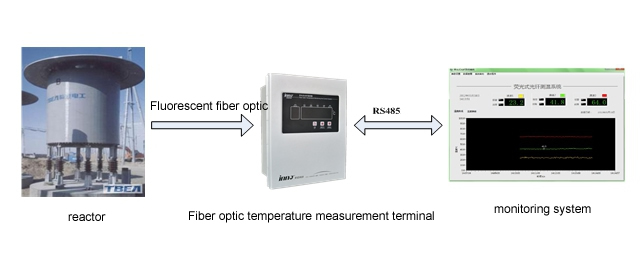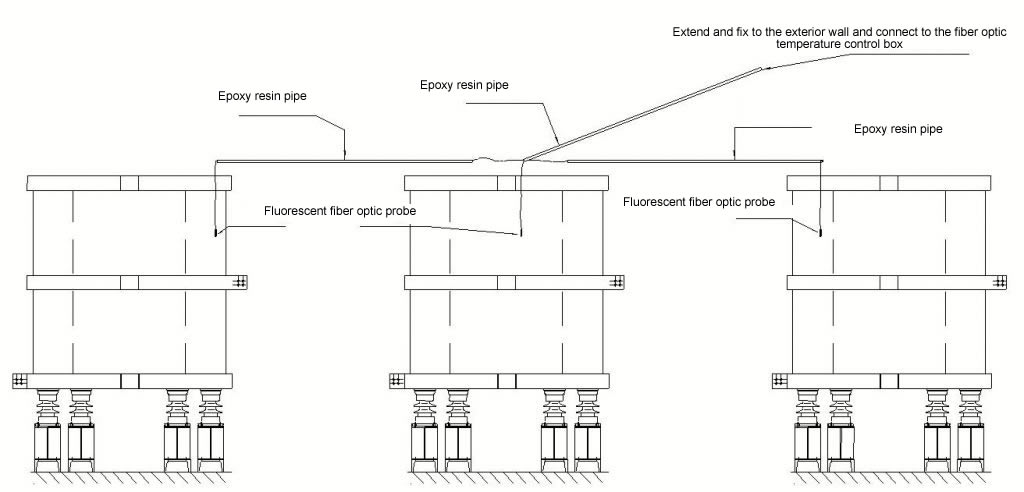Why do reactors need temperature measurement? Pūnaha inenga pāmahana whakaata tākaka
Reactors are the main auxiliary equipment of long-distance transmission systems, playing an important role in power transmission due to their superior electrical performance. During the operation of a reactor, it is often due to external factors, internal structure, and other factors that the reactor may experience local temperature rise and overheating, ultimately leading to local burnout or even scrapping. This brings significant economic losses to the country and enterprises. Nō reira, adopting a reactor fiber optic temperature measurement system and real-time monitoring of the internal temperature of the reactor is of great significance and practical value.
The reactor fiber optic temperature measurement adopts a fluorescent fiber optic temperature measurement device. The sensing probe of this device is made of imported quartz fiber, which has complete electrical insulation and is not affected by high voltage and strong electromagnetic fields. It is resistant to chemical corrosion and pollution, and has fast response speed, simple installation, and high temperature resistance. The backend software is used for real-time online monitoring.
Purpose of Reactor Fiber Optic Temperature Measurement System
When the reactor sends abnormal or faulty signals, the faulty area of the reactor heats up and the temperature rises. By monitoring the temperature, the operating status of the reactor can be determined, thereby achieving the goal of protecting the reactor.
Ordinary temperature measurement devices cannot measure the internal temperature of reactors. To solve this problem, our company’s developed fluorescent fiber optic temperature measurement system can solve this problem through its anti-interference and high-temperature and high-pressure resistance characteristics.
Design principles of fiber optic temperature measurement host for reactors
Principle of practicality
The system construction adheres to the principle of practicality. On the basis of practicality, progressiveness and foresight are considered, and standard, advanced and mature products and development platforms are selected to build a system that is practical and solves practical problems.
Standardization principle
Business applications have the characteristics of complex business, numerous processes, large amount of information, and multiple application levels. Through unified application function planning, consensus can be reached on business operations at the application level, guiding various business units to carry out business with unified standards.
The system software and hardware platforms and application development tools used in the construction of business applications should comply with national standards, standards of the Ministry of Information Industry, relevant technical specifications and requirements of the company.
The principle of uniformity
Following the policy of centralized information management, overall planning, overall design, and step-by-step implementation, the implementation process embodies four unified principles: unified leadership, unified planning, unified standards, and unified organization and implementation.
Reliability principle
The software and hardware resources need to ensure the uninterrupted and reliable operation of the cable temperature measurement system for 7 × 24 hours. Nō reira, it is necessary to equip a complete design of reliability measures to ensure the high reliability of system operation and fully consider the reliability requirements of key system applications.
Reliable security mechanism
This system adopts a series of secure encryption measures, with a built-in 64 bit encryption algorithm. The system has higher security and can effectively prevent data leakage and theft, ensuring the security, tika, and integrity of the system’s data, and preventing illegal operator operations and legitimate operator illegal operations. A system may be used by multiple operators, and to ensure system security, hierarchical permission management is implemented. The system administrator authorizes operators with different usage permissions, and each operator can only perform various operations within the scope of permissions, resulting in higher system security.
The operation interface is simple, friendly, and highly intelligent
The system provides most of the default data required during operation, and each operation conforms to the actual business workflow, avoiding repetitive operations by operators. The system automatically checks the legality of the input data and provides friendly prompts for operator errors.
Reasonable system structure design, high degree of abstraction of program functional modules
It can be flexibly configured according to the changes in the actual situation of users and the various needs of different users, to maximize the satisfaction of user needs. There are various rate management and multi type table management functions for users to better use this system.
The system adopts a Web Service platform and a B/S architecture design, which is in line with the trend of application development.
Stable operation, reliable data, actual operation of thousands of systems, and over 200 new projects added each year.
The platform is easy to operate, easy to master, and the installation process is simple. Data can be automatically generated into various reports as needed, improving management efficiency.
Introduction to the installation of temperature measurement wiring for reactors
1.1 Structural framework
The system consists of three parts: a fluorescent fiber optic pūmana pāmahana, a fluorescent fiber optic probe, and fiber optic communication software.
Reactor temperature measurement
The data transmission between the backend system and the temperature measurement terminal adopts RS485 communication method. All data collection, management, and temperature display are completed by communication software, and the system mainly realizes data collection and monitoring of temperature measurement. The fiber optic temperature measurement terminal integrates multi-channel fluorescent optical fibers, providing external RS485 communication, ārai whakararuraru, and corrosion-resistant design.

The fluorescent fiber optic temperature measurement terminal is embedded and installed in the box, and the outgoing fiber optic goes towards the upper part of the wall, which needs to exceed the height of the reactor. After passing through the epoxy resin pipe installed on the wall, the three fiber optic cables are combined and enter the B-phase reactor; The B-phase optical fiber is directly installed inside the inner airway wall of the reactor; A. The two phases of C are respectively introduced into the A-phase and C-phase reactors through overhead insulated epoxy resin pipes, and installed in the inner air duct wall of the reactor.
Application functions of fluorescent fiber optic temperature measurement system
Real time monitoring of fluorescent fiber optic temperature measurement system
The data collection density can be set according to customer needs, and the system will collect data regularly based on the set parameters. Kātahi, it will be displayed in table form or curve drawing to achieve real-time monitoring. Real time monitoring of equipment operation status; Real time monitoring and recording of reactor temperature.
Basic functions of fluorescent fiber optic temperature measurement system
1) Temperature data query
You can query temperature data for specified dates, browse, print, and export to Excel.
2) Historical temperature data storage
3) Permanently record temperature data
Safety Design of Fluorescent Fiber Optic Temperature Measurement System
The security of the system is crucial, therefore, in the design of the main station system, the security of the system should be fully considered to prevent unauthorized intrusion and leakage of confidential information. From the perspective of main station system security protection, the system provides security protection in both communication channels and system data.
Data security of fluorescent fiber optic temperature measurement system
Equipped with three-level security mechanisms at the operating system level, database level, and application software level.
Operating system level: Set different permission passwords on the network, non system administrators cannot operate servers and databases, and ensure system security and relative independence through routing, firewall, and other settings.
Database level: Set up demanders with different permissions and corresponding passwords in the database to ensure that unauthorized demanders cannot use data, and different demanders cannot use data beyond their level.
Application software level: Provides strict user login verification, permission control, and comprehensive management of event logs and operation records. System permission control includes functional permission control and data access permission control.


Function permission control:
The functional permission control system manages permissions from three dimensions: control objects, object operations, and operators. Based on this, it provides authorization methods for control object groups, operation groups, and operator roles. The accuracy of permission control can be determined to specific control objects and operators. The system determines the operation permissions of the login personnel based on these three dimensions.
The control objects of the system include system level nodes, terminal devices, ērā atu mea. Each control object has corresponding operations, and each authorization includes three parts: a control object group, an operation or operation group, and an operator role. In order to simplify and facilitate permission management, the system provides control object group permission inheritance.
The system provides a hierarchical authorization mechanism, which enables the system to have the ability of distributed permission management and solves the problem of overly complex permission management.
Data access permissions:
The data access permission control mechanism adopts the security audit mechanism provided by the database, providing data access user control, and providing log auditing for all data operations.
The original database only has query functionality, and the applications used only operate on the application database to ensure data security.
The system can store electricity consumption data with time markers and various analytical application calculation data, with a storage time of more than 2 tau. Hei tāpiri atu, the system has a powerful backup subsystem.
Detailed operation log records are available for all manual intervention data. The system design ensures high fault tolerance, and the database has three levels of data validation: field level, record level, and database level, ensuring the storage of illegal data.
Introduction to Fiber Optic Temperature Measurement Equipment for Reactors
1.1 Main features
The fluorescent fiber optic temperature controller is embedded installation. This product has unique technical advantages in temperature measurement in special environments such as high voltage, whakararuraru autō ā-hiko kaha, ērā atu mea. The temperature hotspot and measurement signal receiving part of the fluorescent fiber optic temperature sensor do not use electrical connections, which can work with high precision and stability for a long time, greatly improving its application range. I te wā kotahi, the fiber optic temperature controller effectively eliminates the hidden dangers of local temperature rise and overheating that may occur during the operation of the reactor, ultimately leading to the burnout and scrapping of the reactor, which is not conducive to the safe operation of the reactor. The fiber optic temperature controller has high accuracy and sensitivity, is resistant to high pressure and can be remotely monitored, has a long lifespan, is small in size, makes instrument maintenance simple and convenient, and ensures safe transportation. Its internal modular integrated design is aesthetically pleasing and reasonable.
1.2 Main functions
Can install an integrated multi-channel fluorescent fiber optic temperature measurement and demodulation instrument;
LED digital tube touring display of reactor hot spot temperature;
Provide RS485 communication interface to connect with upper computer instruments and provide temperature acquisition and transmission;
Fan start stop function, providing a pair of fan control output contacts (AC220V, 10A);
Over temperature alarm function, over temperature trip function, temperature control fault alarm function, each providing a pair of normally open output dry contacts.
Pūoko pāmahana whakaata Fiber, Pūnaha aroturuki Intelligent, kaiwhakanao whakaata tākainga tūari i Haina
 |
 |
 |
 Ngā pūoko pāmahana whakaata WEu INNO ,pūnaha aroturuki pāmahana.
Ngā pūoko pāmahana whakaata WEu INNO ,pūnaha aroturuki pāmahana.


WhatsApp
Karapatia te Waehere QR hei tīmata i tētahi kōrerorero WhatsApp ki a mātou.